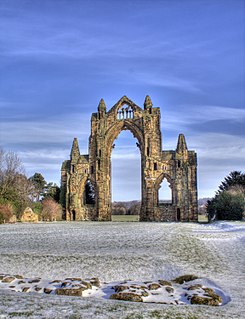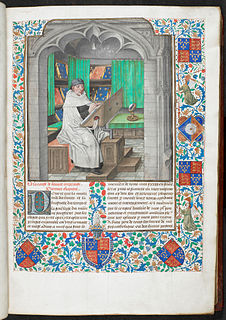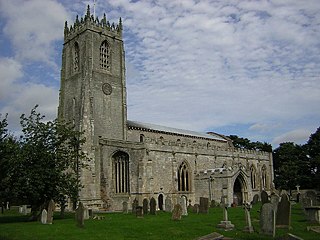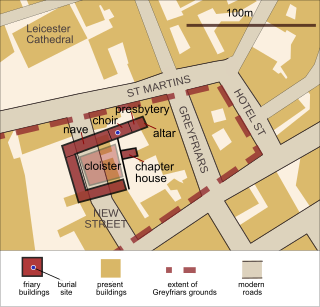
The Carthusians, also known as the Order of Carthusians, are an enclosed religious order of the Roman Catholic Church. The order was founded by Bruno of Cologne in 1084 and includes both monks and nuns. The order has its own rule, called the Statutes, and their life combines both eremitical and cenobitic monasticism. The motto of the Carthusians is Stat crux dum volvitur orbis, Latin for "The Cross is steady while the world turns."

Sherborne Abbey, otherwise the Abbey Church of St. Mary the Virgin, is a Church of England church in Sherborne in the English county of Dorset. It has been a Saxon cathedral (705–1075), a Benedictine abbey church (998–1539), and since 1539, a parish church.

The Dissolution of the Monasteries, occasionally referred to as the Suppression of the Monasteries, was the set of administrative and legal processes between 1536 and 1541 by which Henry VIII disbanded monasteries, priories, convents and friaries, in England, Wales and Ireland, expropriated their income, disposed of their assets, and provided for their former personnel and functions. Although the policy was originally envisaged as increasing the regular income of the Crown, much former monastic property was sold off to fund Henry's military campaigns in the 1540s. He was given the authority to do this in England and Wales by the Act of Supremacy, passed by Parliament in 1534, which made him Supreme Head of the Church in England, thus separating England from papal authority, and by the First Suppression Act (1535) and the Second Suppression Act (1539).

Gisborough Priory is a ruined Augustinian priory in Guisborough in the current borough of Redcar and Cleveland, historic North Riding of Yorkshire, England. It was founded in 1119 as the Priory of St Mary by the Norman feudal magnate Robert de Brus, also an ancestor of the Scottish king, Robert the Bruce. It became one of the richest monastic foundations in England with grants from the crown and bequests from de Brus, other nobles and gentry and local people of more modest means. Much of the Romanesque Norman priory was destroyed in a fire in 1289. It was rebuilt in the Gothic style on a grander scale over the following century. Its remains are regarded as among the finest surviving examples of early Gothic architecture in England.

Scriptorium, literally "a place for writing", is commonly used to refer to a room in medieval European monasteries devoted to the writing, copying and illuminating of manuscripts commonly handled by monastic scribes. However, lay scribes and illuminators from outside the monastery also assisted the clerical scribes.

Netley Abbey is a ruined late medieval monastery in the village of Netley near Southampton in Hampshire, England. The abbey was founded in 1239 as a house for monks of the austere Cistercian order. Despite royal patronage, Netley was never rich, produced no influential scholars nor churchmen, and its nearly 300-year history was quiet. The monks were best known to their neighbours for the generous hospitality they offered to travellers on land and sea.

The London Charterhouse is a historic complex of buildings in Smithfield, London, dating back to the 14th century. It occupies land to the north of Charterhouse Square, and lies within the London Borough of Islington. Originally constructed as a Carthusian priory, on the site of a burial ground, at the Dissolution of the Monasteries it became one of the greatest palaces of Tudor London. In 1611, the property was bought by Thomas Sutton, a businessman and "the wealthiest commoner in England", who established a school for the young and an almshouse for the old. The almshouse remains today, although the school was re-established as Charterhouse School in Godalming, Surrey, in 1872.

Quarr Abbey is a monastery between the villages of Binstead and Fishbourne on the Isle of Wight in southern England. The name is pronounced as "Kwor". It belongs to the Catholic Order of St Benedict.

Thetford Priory is a Cluniac monastic house in Thetford, Norfolk, England. It should not be confused with the Dominican Friary of Blackfriars, Thetford that later became part of Thetford Grammar School.

Cymer Abbey is a ruined Cistercian abbey near the village of Llanelltyd, just north of Dolgellau, Gwynedd, in north-west Wales, United Kingdom.

Mattersey Priory is a former monastery of the Gilbertine order, located near the village of Mattersey, Nottinghamshire, England. It is currently managed by English Heritage.

Blyth Priory was a priory in Nottinghamshire, England, dedicated to St Mary the Virgin.

Great Bricett Priory was a medieval monastic house in Great Bricett in Suffolk, England, the chapel of which is now in use as the Church of England parish church of St Mary and St Lawrence. Ralph FitzBrian and Emma his wife, about the year 1110, founded a priory for Austin canons at Bricett, which was dedicated to the honour of St Leonard. The foundation charter endowed the priory with the tithes of Bricett and of 'Losa' with its chapel, a moiety of the church of 'Stepla,' and the associated church of Stangate, Essex, in addition to various plots of land in the vicinity. The founder also gave to the canons a large garden on the south of the monastery and a smaller one on the east, and he ordained that whenever he was in Suffolk the canons were to act as his chaplains and to receive a tithe of his bread and beer. The priory of Bricett was claimed, early in the thirteenth century, as pertaining to the monastery of Nobiliac, in the diocese of Limoges and the Duchy of Berry. This claim was resisted, but in 1295 an agreement was arrived at favourable to the foreign house, whereby Bricett became an alien priory; this composition was renewed and confirmed by the Bishop of Norwich in the chapter-house of Bricett, on 16 July 1310. In a long list of royal protections to religious houses in 1295, in return for bestowing on the king a tithe of their income, the priory of Bricett is described as a cell to the priory of 'Noblac in Lymoche's'.
Letheringham Priory was a priory in Suffolk, England.

Greyfriars, Dunwich was a Franciscan friary in Dunwich in the English county of Suffolk. The friary was founded before 1277 by Richard FitzJohn and his wife Alice and dissolved in 1538. The original site, which had 20 friars in 1277 when it first appears in records, was threatened by coastal erosion and the friary was moved inland in 1289.

The buildings known as Whitefriars are the surviving fragments of a Carmelite friary founded in 1342 in Coventry, England. All that remains are the eastern cloister walk, a postern gateway in Much Park Street and the foundations of the friary church. It was initially home to a friary until the Dissolution of the Monasteries. During the 16th century it was owned by John Hales and served as King Henry VIII School, Coventry, before the school moved to St John's Hospital, Coventry. It was home to a workhouse during the 19th century. The buildings are currently used by Herbert Art Gallery and Museum, Coventry.

Greyfriars, Worcester is a Grade I listed building in Worcester, England. Its location near to a former friary of the Franciscan order of Greyfriars has in the past led to speculation that it was constructed as their guest house, but it is now believed to have been built as a house and brew-house c.1485 for Thomas Grene, brewer and High Bailiff of Worcester from 1493-1497. It has been in the ownership of the National Trust since 1966.

The Abbey Church of Saint Peter and Saint Paul, Monkwearmouth–Jarrow, known simply as Monkwearmouth–Jarrow Abbey, was a Benedictine double monastery in the Kingdom of Northumbria, England.

Greyfriars, Leicester, was a friary of the Order of Friars Minor, commonly known as the Franciscans, established on the west side of Leicester by 1250, and dissolved in 1538. Following dissolution the friary was demolished and the site levelled, subdivided, and developed over the following centuries. The locality has retained the name Greyfriars particularly in the streets named "Grey Friars", and the older "Friar Lane".


















